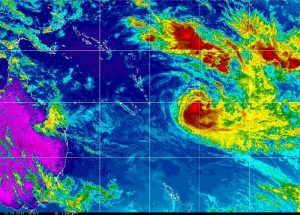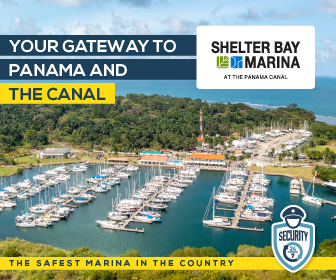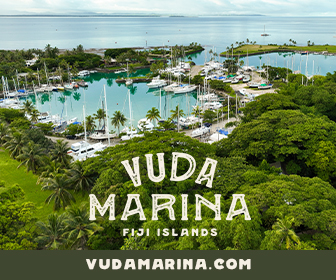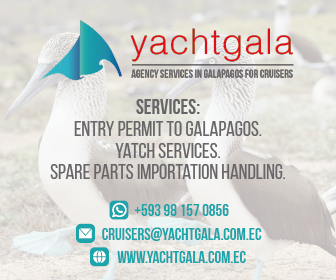South Pacific: Options for Getting Out of the Cyclone Zone
Andy and Sue Warman currently in Gambiers, French Polynesia are thinking ahead to cyclone season in October/November and what options there are for yachts wanting to exit the Pacific. Here they give their thoughts on route and destination options, with comments from cruisers in Guam and Japan.
Published 5 years ago


- Tropical Cyclone Sarai, Fiji
Situation for yachts presently located in French Polynesia and elsewhere in the South Pacific.
By Andy & Sue Warman
s/y Spruce – Rikitea, Gambiers
Background information:
Yachts departed Central/South America and Mexico bound for French Polynesia (FP). The voyages involved are typically distances of 2,900-4,000 miles. Normal cruising sailboats, who cannot carry sufficient fuel to motor those distances, take between 21-40 days to complete their voyages.
French Polynesia introduced new Covid19 rules on 21st March 2020, at which time many vessels had already left their departure ports and were at sea.
It is believed an addendum to the original rules was introduced on 2nd April 2020 recognising the time at sea as part of any quarantine period. However, there is no evidence of that being applied. Vessels arriving after 21st March have been required to undergo a compulsory 14-day quarantine period and to proceed to Tahiti. Vessels already in FP do not have this requirement.
The South Pacific is in a cyclone zone that typically has cyclones between 1st November and 31st April each year. The incidence of cyclones farther west, where sea temperatures are warmer, is higher. FP normally only experiences cyclones during El Nino years when sea temperatures farther east are warmer than the average.
Yacht crews normally cruise a season through the South Pacific and then leave the cyclone risk zone between mid-October and mid-November. Either they go to New Zealand, Australia or to Pacific Islands near the equator (where cyclogenesis does not occur). A smaller number of vessels remain during the cyclone zone in FP or hauled out in marinas at Raitea, Tahiti, Vudu Point (Fiji). Capacity for boats to remain in the cyclone zone is limited.
New Zealand has “locked down” due to Covid19. Other South Pacific nations are not accepting new arrivals. Vessels that would normally depart from NZ on 1st May each year (start of the new cruising season), thereby creating capacity for the next season’s influx, are unlikely to be leaving during 2020. The available capacity for any new arrivals will possibly be limited.
Vessels’ crews currently at the more eastern fringes of the South Pacific island chains are wary of proceeding any farther westwards without a clear exit from the cyclone zone being available in October, before the next cyclone season.
Due to recent large claims against insurance underwriters for vessels damaged due to cyclones, notably in the Caribbean, most insurance policies have a cyclone exclusion clause: this typically states vessels damaged by a named windstorm if located between defined latitudes during the cyclone season are not covered.
If none of the options below prove feasible, then there will be a lot of psychological issues due to depression and anxiety, when crews have to remain in a location that is not considered safe for the boat and crew. A number of sailors have limited time and funds at their disposal.
Specific options to depart from the cyclone zone before November 2020:
1. To the USA via Hawaii
- Yacht crews must already have B1/B2 visas to enter the USA.
- The availability of affordable medical insurance for the USA may be prohibitive or unavailable during the present crisis.
- It is a long way via the normal circular route (e.g. from French Polynesia it is 5,200 miles to California).
- If a crew embarks on that passage the rules may have changed before they arrive.
- Hawaii is in the North Pacific cyclone zone from July to November.
- Hawaii requires a 14-day quarantine regardless of how long crews have been already isolated at sea.
- The USA is an expensive country to leave a boat if crews had not budgeted for that expense and are not allowed to live aboard in less expensive locations at anchor.
1b. See notes on Guam to USA/Alaska at bottom of this report by SV Flying Spirit.
2. To New Zealand
- If NZ opens up to arriving yachts in October, vessels waiting in FP might need to undertake an almost non-stop passage for 3,500 miles (27-35 days).
- A wait for suitable weather to go south, in the vicinity of Tonga, would be inevitable.
- Surely NZ could use some sort of quarantine for arriving vessels to negate the risk of Covid19 being imported aboard a yacht.
- However, as stated earlier, the marina/boatyard capacity in NZ may be limited due to non-departure of the previous year’s cadre.
- Note: The marine trades in NZ might be very desirous of a new influx of boats to bring needed work into their economy.
3. To the Equatorial Regions
- The islands in this region are typically poor nations who are presently closed to new arrivals.
- Availability of supplies of food and fuel are unknown, but probably limited, particularly if many yachts arrived in their waters.
- Yacht crews are more affluent and any influx would likely create shortages for locals which would probably fuel resentment.
4. Long route to Papua New Guinea and then north of New Guinea Island (out of the cyclone zone) and possibly onwards to West Papua.
- These regions are not affluent.
- It is possible the security of yacht crews might be at risk if locals are frightened of Covid19 being brought to them.
- It is a long way – 5,000+ miles.
- It is believed those countries and Indonesian West Papua are presently closed to new arrivals.
5. To Australia
- The northern zone of Australia is also in a cyclone zone.
- South of Bundaberg is normally outside the risk zone.
- Australia is an expensive country to leave a boat if crews had not budgeted for that expense and are not allowed to live aboard in less expensive locations at anchor.
6. To the Panama Canal
- It is a long route via 35 degrees south latitude (4,800 miles), or to windward across the SE Trades.
- The present situation is a 14 day quarantine requirement upon arrival, regardless of time already spent in isolation at sea.
- The use of Panamanian nationals in close proximity aboard is a risk of transmitting Covid19 to the yacht crew.
- Note: we transited the Panama Canal in Dec 2012 and they rafted boats up, only four line handlers were required for each raft of boats. With a will, it would be possible to have a Canal advisor in a separate vessel and with four vessels per raft having 2-crew each, crews would have no direct contact with locals. The present arrangements would not be appealing to many crews.
7. Return to Chile
- We have heard this expressed by people who came from there.
- However, Chile is closed to new arrivals at the present time.
- The route would be south of the South Pacific High Pressure zone and then north to the coast.
8. Non-stop to South Africa
- There is a several-month window about to open up from 1st May 2020 (end of cyclone season) to sail direct to South Africa.
- The normal time to arrive in Durban or Richards Bay would be late October 2020.
- That is a very long way, 11,500 miles.
- For vessels to achieve that distance over a 4 month period is possible but many vessels are reliant on periodic stops for fuel, supplies, maintenance etc.
- Conducting such a passage without a suitable preparation period is probably unrealistic for many crews.
- At the moment South Africa is closed to new arrivals.
Andy & Sue Warman
s/y Spruce – Rikitea, Gambiers
………………………………………………………………………………………………………………………………………………………..
1b. Guam to USA/Alaska
By Austin Baird
SV Flying Spirit
Guam is presently halfway through its dry season. Typhoon season typically commences in July with August thru December most active. Typhoons have struck Guam in every month. The most recent ENSO reports for 2020 does not indicate that this will be an overly active year.
Guam is a US Territory and all visa / passport requirements for entering the US apply. For yachts returning to the US there is a window of weather typically between May and July to cross the Pacific to Alaska. We have 2 visiting yachts who have been caught up in the Covid 19 restrictions who are now rerouting and set to leave Guam in the next week or so for Alaska. Most consider that passage still 3-4 weeks early and non-stop should be approximately 4-5 weeks duration from Guam depending on conditions.
I expect that a yacht arriving Guam in the next 4-5 weeks could potentially make safe passage to Alaska in the 2020 window.
Guam has a typhoon hole in the Harbor of Refugee. Rates are approx.. $250/mo.. There is limited area for storage on land and there is no boat lift for yachts. Removing a boat from the water by crane typically costs $1300-1800 per lift.
By executive order of the Governor of Guam all arrivals require 14 days quarantine in a government designated facility. Forecast of this order is to 05 May 2020 pending progress on the fight against the virus. Guam has had 135 civilian cases and 5 fatalities from Covid 19 since mid-March. It appears that the curve is flattening but testing has been low with only persons with severe symptoms being tested. Guam continues to try to source test kits to increase sample size.
Information and updates regarding Covid 19 status on Guam can be obtained at the DPHSS website here: http://dphss.guam.gov/covid-19/
Austin Baird
SV Flying Spirit
………………………………………………………………………………………………………………………………………………………..
9. Japan
By Kirk Patterson of Konpira Consulting
A final destination that perhaps South Pacific cruisers had not considered is Japan. With the current Pacific shut-downs and the fact that Japan is open to the majority of cruisers (albeit with quarantine on arrival), this could be an alternative destination for the season.
See Japan Biosecuity for details.
Kirk Patterson of Konpira Consulting (an ex-cruiser) reports:
A number of marinas have closed to visitors (Japanese and foreign) although there may be some case-by-case flexibility. I just got annual moorage for one client and a few days for another client and currently negotiating for one of my clients that needs to leave his boat in Japan for nine months starting in July. Some other marinas are still open, fishing ports are still open and of course all anchorages are fine.
Andy and Sue of SY Spruce sailed through Japan in Mar-Jun 2018 on their way to the Aleutians and Alaska. They say; “For boats in FP it is a long way to Japan. Typhoons can happen any month in the NW Pacific Ocean. The routes to leave Japan are either south to the Philippines/SE Asia during the NE monsoon season, across to the Americas (long way) or our route to the Aleutians, Alaska (initially 1350 miles to Attu – very cold waters) then along the windy Aleutian chain to Dutch Harbor. Fuel was available at Sweepers Cove, Adak in June 2018 and at Dutch Harbor. How supplies are affected at the present time we do not know.
With the situation changing on a daily basis be sure to check Noonsite’s COVID-19 Document to help with your planning and associated links to each country’s biosecurity section for further details.
………………………………………………………………………………………………………………………………………………………..
Related Reports:
- New Zealand’s Current Position for Yachts under COVID-19 Restrictions (18 April)
- South Pacific Cyclone Season in the tropics: Calculated risks
- Pacific Cyclone Season: North instead of South
Useful Links:
- USA Formalities
- Panama Formalities
- Chile Formalities
- Papua New Guinea Formalities
- New Zealand Formalities
- Australia Formalities
- South Africa Formalities
- Japan Formalities
………………………………………………………………………………………………………………………………………
The opinions expressed in this article are the authors’ own and do not reflect the view of Noonsite.com or World Cruising Club.
Related to following destinations: Australia, Chile, Cook Islands, Fiji, French Polynesia, Guam, Japan, New Zealand, Panama, Papua New Guinea, South Africa, Tonga, USA
Related to the following Cruising Resources: COVID-19, Hurricanes and Tropical Cyclones, Pacific Crossing, Pacific Ocean South, Pacific Ocean West, Routing, Weather











The comment in this article that reads:
“Australia is an expensive country to leave a boat if crews had not budgeted for that expense and are not allowed to live aboard in less expensive locations at anchor” is a generalisation and factually incorrect.
Living aboard at anchor is permitted almost everywhere in Australia however there are some time restrictions in certain locations.
In regard to cost of vessel storage and cost of living in Australia below is a statement provided by the vessel s.v Avalon who has spent 2 seasons in New Zealand before coming to Australia for a season in 2019:
“From our experience of being in Australia since early November 2019 the normal living costs are less than New Zealand. The ‘typical’ weekly shop seems to be less here in Australia, particularly in the more rural or non CBD areas and away from Sydney. In our time spent in Queensland, from Bundaberg down to Moreton Bay and the Gold Coast, it’s apparent that both grocery shopping and eating out in bars and restaurants is at worst comparable, but in most cases 15-20% less expensive than the equivalent
in New Zealand.
This was a surprise to us, and added to this is the GST which is 10% in Australia compared to 15% in New Zealand. Clearly, Sydney is more expensive than other parts of Australia, but Sydney aside, the cost of living in Australia is less than New Zealand…. and the coffee is still good, even if the beer requires much
sampling to find your preferred brew!
Being a foreign registered vessel in New Zealand allows us to be exempt from the 15% GST on all marine equipment and marine safety related goods and services. Our limited experience (at this time) of looking at the comparative costs of similar goods and services in Australia indicates that in many cases the prices are again less in Australia than New Zealand.
There is also more choice of marine equipment and parts available and there seems to be a vast network of options for marine services, vendors and contractors. The cost differential is more noticeable for the larger high-value equipments which are more likely to be available in Australia, but often have to be
imported into New Zealand at extra cost. In these cases it is likely that the final price for these items in Australia will be less than New Zealand (even with the 15% GST discounted).”
Tom Prior
s.v Avalon
16th January 2020